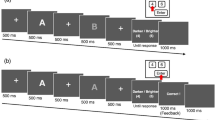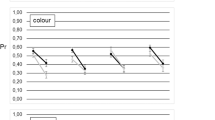Mental arithmetic in people with synaesthesia is not coloured by visual experience.
Abstract
In synaesthesia, ordinary stimuli elicit extraordinary experiences. For example when C., who is a digit–colour synaesthete, views black digits, each number elicits a photism — a visual experience of a specific colour. It has been proposed that synaesthetic experiences differ from imagery in their consistency1, automaticity2,3 and reliance on external stimuli to induce them4. Here we demonstrate that C.'s photisms are both consistent and automatic, but we find that an externally presented inducing stimulus is not necessary to trigger a photism and that simply activating the concept of a digit is sufficient.
Similar content being viewed by others
Main
As a measure of consistency, we asked C. to name the colour of her photisms elicited by the digits 1 to 9 shown in random order, 10 times each. C.'s pairings between digits and colour names were 100% consistent across repetitions.
To assess automaticity, we used a Stroop task. Colour-naming reaction times were recorded for coloured squares (baseline condition) or for digits displayed in colours that were either congruent or incongruent with C.'s photisms (Fig. 1). Her mean reaction times for each condition were: congruent, 552 ms (error, 1.4%); baseline, 545 ms (error, 0.0%); incongruent, 797 ms (error, 2.8%). An analysis of variance (F(2,410) = 74.88, P < 0.001) and Tukey post-hoc analyses revealed that incongruent trial reaction times were significantly slower than baseline (P < 0.001) and congruent trial reaction times (P < 0.001) — the last two conditions did not differ.
a, Digit Stroop task: on each trial, reaction times were recorded for naming coloured squares (‘baseline’) or digits displayed in colours that were either congruent or incongruent with C.'s photism colours. There were 144 trials of each type, randomly intermixed. b, Arithmetic Stroop task: on each trial, participants were presented, in sequence, with a fixation cross, a digit, an arithmetic operator, a second digit, and a colour patch. Participants named the colour patch as quickly as possible and then reported the arithmetic solution. Colour patches were either congruent (108 trials) or incongruent (324 trials) with C.'s photism colours for the arithmetic solutions. Trial types were intermixed. Further details are available from the authors.
C.'s large significant difference in congruent/incongruent reaction times (245 ms) contrasts with the small, non-significant, congruent/incongruent differences (ranging from −11 to 17 ms) of eight non-synaesthetes tested using identical stimuli. Figure 1a shows the Stroop performance of C. and of the non-synaesthete most similar to C. in terms of baseline-trial colour-naming reaction times. C.'s performance indicates that the digits automatically elicited photisms that interfered with her colour-naming on incongruent trials.
For C., viewing the digit 7 automatically induces a yellow photism. To assess whether C.'s photisms could be elicited without physically showing her an inducing stimulus, we presented, in sequence, a digit (for example, 4), an operator (for example, +), a second digit (for example, 3), and a colour patch. C. had to name the colour patch as quickly as possible, and then report the solution to the arithmetic problem. On each trial, the colour patch was either congruent or incongruent with the photism associated with the arithmetic solution. For example, 5 + 2 was followed either by a yellow patch, which is congruent with C.'s photism colour for 7, or a red patch, which is incongruent with C.'s photism for 7. To discourage C. from using the arithmetic solution to predict the colour of the patch, we presented three times as many incongruent trials as congruent trials.
If automatic photisms can be induced simply by calculating the solution to arithmetic problems, then they should interfere with C.'s ability to name the colour of the patch on incongruent trials but not on congruent trials. Consistent with our reasoning, C.'s colour-naming reaction times were significantly slower on incongruent trials (mean, 650 ms) than on congruent trials (mean, 414 ms), t(390) = 19.48, P < 0.001. This large congruent/ incongruent difference (236 ms) was 19.3 standard deviations away from the mean difference (1 ms) obtained for eight non-synaesthetes. Figure 1b shows C.'s performance compared with the performance of the non-synaesthete who was most similar to C. in terms of overall reaction times.
C.'s large difference in congruent/incongruent reaction times (236 ms) indicates that automatic photisms were induced by the arithmetic solution (for example, the yellow photism associated with the digit 7 was generated in response to calculating 5 + 2). This suggests that an external stimulus (for example, a physically present numeral 7) is not required to trigger a photism. Rather, activating the concept of a digit by a mental calculation was sufficient to induce a colour experience. Thus, although C.'s photisms are both consistent and automatic, they do not require a physical inducing stimulus to elicit them.
Stroop-type paradigms have shown that photisms are automatic and involuntary4. Brain imaging has demonstrated that photisms activate visual-association areas involving binding colour to form5. Cognitive research, brain imaging and even genetics (synaesthesia runs in families)6 all attest to the reality of synaesthesia. Although the neural architecture and neurodevelopmental aspects of synaesthesia are not yet fully understood, the finding that photisms can be concept-driven may help to guide our understanding of this rare phenomenon.
References
Baron-Cohen, S., Wyke, M. & Binnie, C. Perception 16, 761–767 ( 1987).
Mills, C. B., Boteler, E. H. & Oliver, G. K. Cogn. Neuropsychol. 16, 181 –191 (1999).
Odgaard, E. C., Flowers, J. H. & Bradman, H. L. Perception 28, 651– 664 (1999).
Cytowic, R. E. The Man who Tasted Shapes (Putnam, New York, 1993).
Frith, C. D. & Paulesu, E. in Synaesthesia: Classic and Contemporary Readings (eds Baron-Cohen, S. & Harrison, J. E.) 123– 147 (Blackwell, Cambridge, Massachusetts, 1997).
Bailey, M. E. S. & Johnson, K. J. in Synaesthesia: Classic and Contemporary Readings (eds Baron-Cohen, S. & Harrison, J. E.) 182–210 (Blackwell, Cambridge, Massachusetts, 1997).
Author information
Authors and Affiliations
Corresponding author
Rights and permissions
About this article
Cite this article
Dixon, M., Smilek, D., Cudahy, C. et al. Five plus two equals yellow. Nature 406, 365 (2000). https://doi.org/10.1038/35019148
Issue Date:
DOI: https://doi.org/10.1038/35019148
This article is cited by
-
In Defense of Jñānalakṣaṇā Pratyāsatti
Journal of Indian Council of Philosophical Research (2023)
-
Synesthesia does not help to recover perceptual dominance following flash suppression
Scientific Reports (2021)
-
Apparent physical brightness of graphemes is altered by their synaesthetic colour in grapheme-colour synaesthetes
Scientific Reports (2020)
-
Synaesthesia-type associations and perceptual changes induced by hypnotic suggestion
Scientific Reports (2017)
-
Why Saturday could be both green and red in synesthesia
Cognitive Processing (2016)
Comments
By submitting a comment you agree to abide by our Terms and Community Guidelines. If you find something abusive or that does not comply with our terms or guidelines please flag it as inappropriate.




